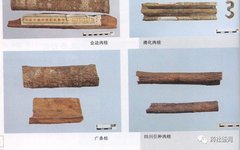Cinnamon BarkRouguiCINNAMOMI CORTEX1. 2020 Edition of the Chinese Pharmacopoeia
This product is the dried bark of the plant Cinnamomum cassia Presl, belonging to the Lauraceae family. It is harvested in the autumn and dried in the shade.
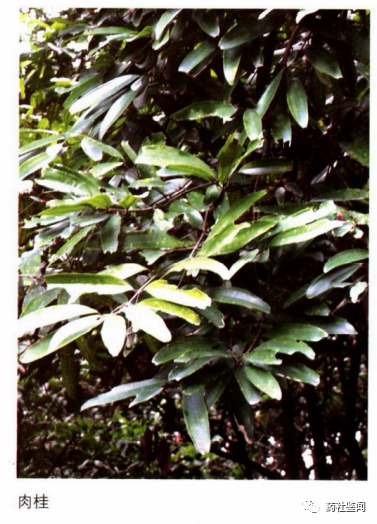
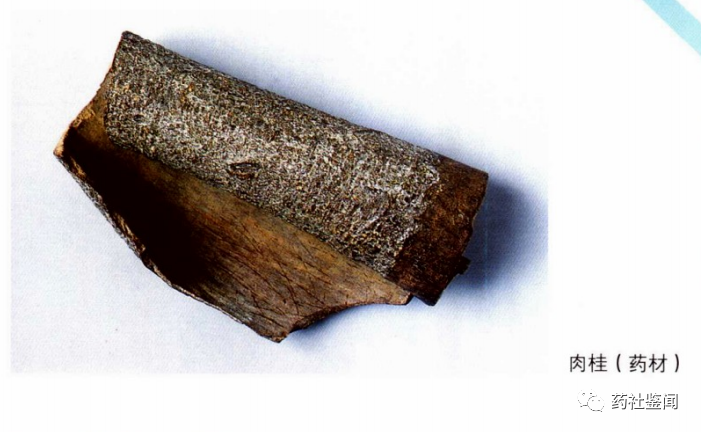
【Characteristics】 This product is in a channel or rolled shape, measuring 30-40 cm in length, 3-10 cm in width or diameter, and 0.2-0.8 cm in thickness. The outer surface is gray-brown, slightly rough, with irregular fine wrinkles and transverse raised pores, some of which may show gray-white spots; the inner surface is reddish-brown, slightly flat, with fine longitudinal lines, and shows oily marks when scratched. It is hard and brittle, easily broken, with an uneven fracture surface; the outer layer is brown and rough, while the inner layer is reddish-brown and oily, with a yellow-brown line pattern between the two layers. It has a strong aromatic scent and a sweet, spicy taste.
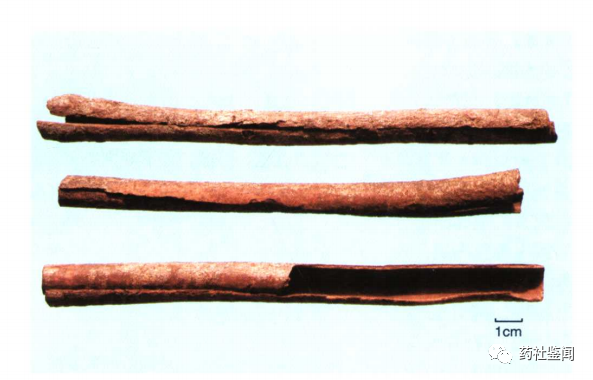
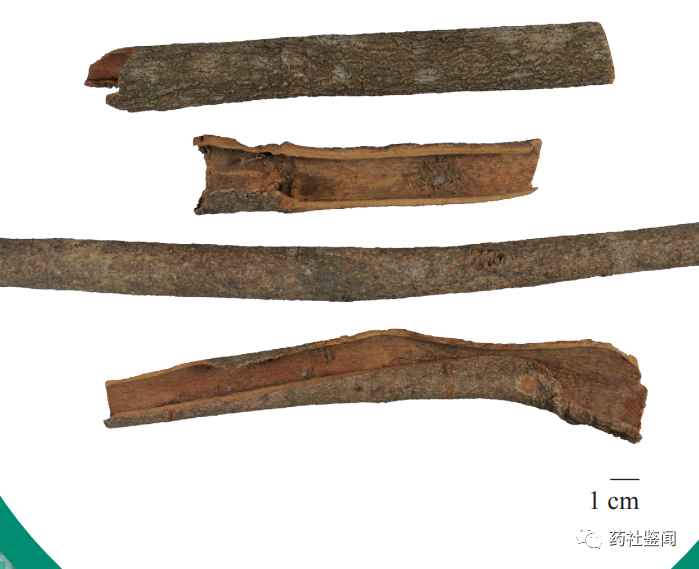
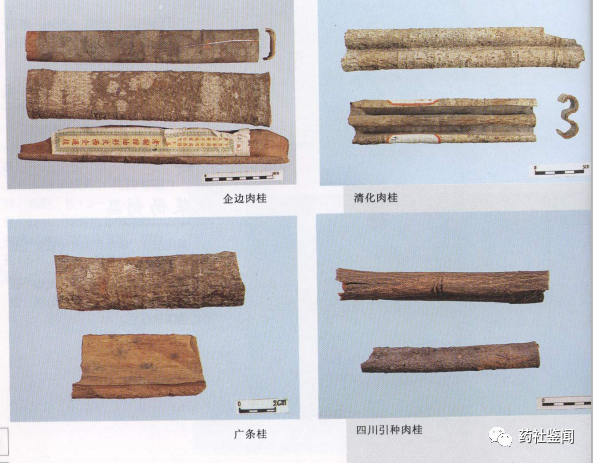
【Identification】 (1) Cross-section of the product: The cork cells are arranged in rows, with the innermost cell walls thickened and lignified. The cortex contains scattered stone cells and secretory cells. In the central sheath area, stone cell clusters are intermittently arranged in a ring, accompanied by fiber bundles, with stone cells usually having thinner outer walls. The phloem rays are 1-2 cell rows wide, containing small calcium oxalate needle crystals; fibers are often in bundles of 2-3; oil cells are found throughout. Parenchyma cells contain starch granules.
The powder is reddish-brown. Most fibers are scattered individually, elongated spindle-shaped, measuring 195-920 μm in length and about 50 μm in diameter, with thick walls and indistinct pores. Stone cells are square or round, with a diameter of 32-88 μm, thick walls, some with thin sides. Oil cells are round or elongated, with a diameter of 45-108 μm. Calcium oxalate needle crystals are small and scattered among the ray cells. Cork cells are polygonal and contain reddish-brown substances.
(2) Take 0.5 g of the powdered product, add 10 ml of ethanol, and soak in cold for 20 minutes, shaking occasionally, then filter to obtain the test solution. Additionally, take a standard solution of cinnamaldehyde, prepared in ethanol to contain 1 μl per 1 ml, as the control solution. Perform thin-layer chromatography (TLC) according to the general method 0502, applying 2-5 μl of the test solution and 2 μl of the control solution on the same silica gel G TLC plate, using petroleum ether (60-90°C) - ethyl acetate (17:3) as the developing agent, develop, remove, dry, and spray with 2,4-dinitrophenylhydrazine ethanol solution. In the test solution chromatogram, a spot of the same color appears at the corresponding position as in the control solution chromatogram.
【Examination】 Moisture content must not exceed 15.0% (General Rule 0832, Method 4).
Total ash content must not exceed 5.0% (General Rule 2302).
【Content Determination】 Volatile oil is determined according to the volatile oil determination method (General Rule 2204, Method B).
The product must contain no less than 1.2% (ml/g) of volatile oil.
Cinnamaldehyde is determined by high-performance liquid chromatography (HPLC) (General Rule 0512).
Chromatographic conditions and system suitability test: Use octadecylsilyl-bonded silica gel as the stationary phase; use acetonitrile-water (35:75) as the mobile phase; detection wavelength is 290 nm. The theoretical plate number calculated for the cinnamaldehyde peak should not be less than 3000.
Preparation of the control solution: Take an appropriate amount of cinnamaldehyde standard, accurately weigh, and dissolve in methanol to prepare a solution containing 10 μg per 1 ml.
Preparation of the test solution: Take about 0.5 g of the powdered product (passed through a No. 3 sieve), accurately weigh, place in a stoppered conical flask, accurately add 25 ml of methanol, weigh, sonicate (power 350W, frequency 35kHz) for 10 minutes, let sit overnight, sonicate again in the same manner, then weigh, and use methanol to make up for any weight loss, shake well, and filter. Accurately take 1 ml of the filtrate, place in a 25 ml volumetric flask, and add methanol to the mark, shake well, and it is ready for use.
Determination method: Accurately inject 10 μl of both the control solution and the test solution into the liquid chromatography system for measurement.
The product must contain no less than 1.5% of cinnamaldehyde (C9H8O) based on the dried product.
2. Chinese Herbal Pieces
【Processing】 Remove impurities and coarse bark. Crush before use.
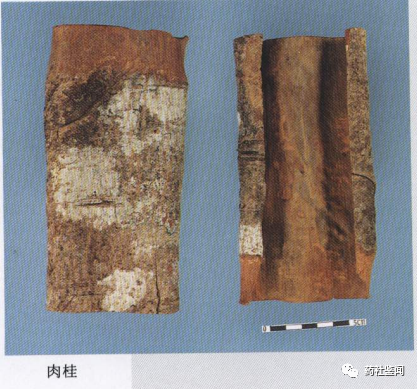
【Characteristics】【Identification】【Examination】 Same as the raw material.
【Flavor and Meridian Entry】 Pungent, sweet, and very warm. Enters the Kidney, Spleen, Heart, and Liver meridians.
【Functions and Indications】 Tonifies fire and assists Yang, directs fire back to the source, disperses cold and alleviates pain, warms and unblocks the meridians. Used for impotence due to cold in the womb, cold pain in the lower back and knees, cough due to kidney deficiency, floating Yang, dizziness, red eyes, cold pain in the heart and abdomen, vomiting and diarrhea due to deficiency-cold, cold hernia abdominal pain, dysmenorrhea, and amenorrhea.
【Dosage】 1-5 g.
【Cautions】 Use with caution in those with bleeding tendencies and pregnant women; not suitable for use with red stone fat.
【Storage】 Store in a cool, dry place.
3. Identification:
1. Genuine Product: 【Source】 This product is the dried bark of the plant Cinnamomum cassia Presl.
【Genuine Product Image】
Image 1: Domestic cinnamon medicinal material image
【Main Identification Points】 (1) Raw material: This product is in a channel or rolled shape, measuring 30-40 cm in length, 3-10 cm in width or diameter, and 0.2-0.8 cm in thickness. The outer surface is gray-brown, slightly rough, with irregular fine wrinkles and transverse raised pores, some of which may show gray-white spots; the inner surface is reddish-brown, slightly flat, with fine longitudinal lines, and shows oily marks when scratched. It is hard and brittle, easily broken, with an uneven fracture surface; the outer layer is brown and rough, while the inner layer is reddish-brown and oily, with a yellow-brown line pattern between the two layers. It has a strong aromatic scent and a sweet, spicy taste.
Image 2: Identification points of cinnamon
(2) Herbal pieces: Take cinnamon, remove impurities and coarse bark, and crush.
It appears as irregular fragments, often with the outer coarse bark removed, with both inner and outer surfaces being reddish-brown. The edges are uneven, granular, with a yellow-brown line pattern in the middle of the fracture surface. It has a strong aromatic scent and a sweet, spicy taste.
Image 3: Image of cinnamon herbal pieces
2. Main Identification Points for Counterfeit Products (1) Ground Cinnamon (Yinxiang) - Dried bark of the plant Cinnamomum burmannii (Nees et T.Nees) BL.
This product is channel-shaped, plate-shaped, or irregular block-shaped, with a thickness of 0.1-0.6 cm. The outer surface is gray-brown or gray-brown, with gray-white spots and irregular fine textures. The inner surface is dark reddish-brown, smooth, with indistinct oily marks when scratched. It is hard and brittle, easily broken, with a new surface that is reddish-brown and rough, and the inner and outer layers are not clearly defined, without a yellow-brown line pattern. It has a camphor scent, slightly sweet.
The main differences from the genuine product are: This product is channel-shaped, tubular, or plate-shaped, varying in length, with a thickness of 0.1-0.6 cm. The outer surface is gray-brown to black-brown, slightly rough, without transverse raised pores; the inner surface is dark reddish-brown, flat, with weak oily marks when scratched. It is hard and brittle, easily broken, with an uneven fracture surface, and no yellow-brown line pattern between the inner and outer layers. It has a fragrant scent, with a slightly sweet and astringent taste.
(2) Chai Cinnamon - Bark of the plant Cinnamomum tamala (Buch-Ham.) Nees et Eberm.
This product is channel-shaped, semi-tubular, or irregular block-shaped, with a thickness of 0.4-1.5 cm. The outer surface is gray-brown, rough, sometimes showing gray-white spots. The inner surface is dark reddish-brown, with indistinct oily marks when scratched. It is hard, not easily broken, with an uneven fracture surface, and the inner and outer layers are not clearly defined, with a thicker outer layer. The cut surface has numerous slightly glossy yellow-white spots, while the inner layer is thinner and dark brown, with strong oiliness. It has a camphor scent and a slightly sweet taste.
(3) San Zuan Feng - Bark of the plants Lindera obtusiloba L. and Lindera umbellata Thunb.
This product is channel-shaped or semi-tubular, with a thickness of 0.2-0.4 cm. The outer surface is gray-brown, with irregular fine wrinkles, occasionally showing transverse grooves and white spots. The inner surface is dark reddish-brown, slightly smooth, with indistinct fine longitudinal lines, hard and brittle, easily broken, with an uneven fracture surface; the outer layer is light yellow-brown, while the inner layer is reddish-brown and oily. It has a faint aromatic scent and a mild taste.







